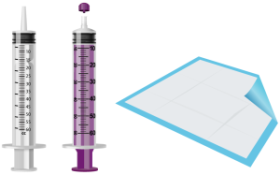This information explains how to test your stomach pH level at home through your orogastric (OR-oh-GAS-trik) or nasogastric (NAY-soh-GAS-trik) tube. Orogastric and nasogastric tubes are usually called OG and NG tubes.
In this resource, the word “you” refers to you or your child.
About Your OG or NG Tube
An OG tube goes through your mouth into your stomach. An NG tube goes through your nose into your stomach (see Figure 1). Your care team can use your tube to:
- Give you medications when you can’t swallow.
- Give you liquid food when you can’t eat enough by mouth.
- Relieve gas or air pressure from your stomach.

Figure 1. OG tube (left) and NG tube (right)
About Your Stomach pH Level
Your stomach pH tells your healthcare provider if your tube is in the right place in your stomach. Your care team will test your stomach pH level using stomach fluid they take through your tube. They will test your stomach pH:
- Right after placing your tube.
- Between feedings or medication doses.
- If they think your tube may have moved.
pH levels range from 0 to 14. If your stomach pH is above 5.5, this means your tube may have moved. Your care team may need to remove or replace your tube.
How To Test Your Stomach pH Level at Home
You will need to keep testing your stomach pH level at home. Your healthcare provider will tell you when and how often to test. This will usually be once a day. You may also need to test before you eat or take medication through your tube.
Supplies
Your care team will give you supplies, or home care will send them to you. You’ll need:
- A 60 milliliter (mL) syringe. You will get either a Slip tip or ENFit® syringe (see Figure 2). This will depend on the type of NG tube you have.
- Plastic or paper pH strips (see Figure 3). Each type works the same way.
- Disposable medical gloves.
- A clean, dry paper towel or disposable waterproof plastic pad.
- A trash can.
You can buy these supplies at your local drug store if you need more.

Figure 2. Slip tip syringe (left), ENFit syringe (center), and waterproof pad (right)

Figure 3. Plastic pH test strips (left) and paper pH test strips (right)
Instructions
- Clean and dry your hands.
- Set up your supplies on a clean, flat surface. If you have pre-cut pH test strips, take out 1 strip. For pH strips a roll, rip off a piece long enough to put a drop of stomach fluid on it.
- Pull the plunger of the syringe back to the 5 to 10 mL mark. This fills the syringe with air.
-
Place the tip of the syringe into your tube (see Figure 4). Press the plunger until it’s empty. This will send the air into your stomach. Keep the syringe in your tube.

Figure 4. Slip tip (left) and ENFit (right) syringes in tube - Gently pull the plunger back until there is about 1 mL of stomach fluid in the syringe.
- Take the tip of the syringe out of your tube.
- Squeeze 1 to 2 drops of fluid onto the pH test strip. If you’re using a plastic test strip, make sure to cover the whole pH square.
- Hold the test strip up to the pH indicator on the pH strip package or container. Compare the color of the pH strip to the indicator to find your stomach pH level.
- Write down your pH level and the time you did the test. You can use a pH log, notebook, or notes app on your phone.
- Wrap the used test strip in the paper towel or pad. Throw it away into the trash.
- Squeeze any stomach fluid left in the syringe into the toilet, then flush.
- If you’re reusing your syringe, rinse it with warm water and dry it for the next use.
- Wash your hands.
- Store your unused pH strips in a cool, dry place until your next pH test.
If your stomach pH is 6 or higher, repeat these steps and test again. If it is still higher than 6, call your healthcare provider. Do not put any medication or food into your tube.
When to Call Your Healthcare Provider
Call your healthcare provider if:
- You can’t collect any stomach fluid through your tube.
- Your stomach pH level is 6 or higher.
- You have been vomiting (throwing up).
- You think your tube has moved. For example, you may notice more of your tube is sticking out than it used to. This may mean that your tube has moved, and it isn’t ending where it should inside your stomach.
- You have any questions or concerns.